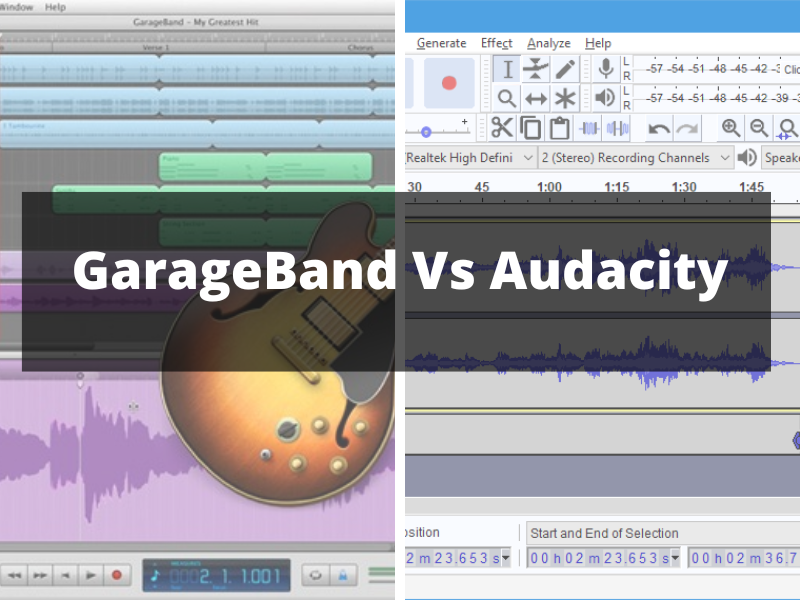You may record, mix, edit, and otherwise alter your beats using either Garageband or Audacity, free music audio editing programs. On the other hand, there are significant distinctions between the two that, depending on your requirements, can lead you to choose one over the other.
For instance, Garageband is a closed-source program that can only be used on Apple Mac, iPhones, and iPads, but Audacity is accessible for free. It can be used on other operating systems. Whereas Audacity is a digital audio editor, this program is more like a fully-fledged Digital Audio Workstation (DAW).
In this side-by-side comparison, we will investigate each software package in further detail so that you can choose the one most suitable for your needs.
Comparison Between Garageband and Audacity
Contents
Garbage Band | Audacity |
Audacity primarily focuses on audio file manipulation and editing, whereas GarageBand is designed for recording, arranging, and composing music with audio and MIDI. GarageBand, on the other hand. | The audio editing tools and effects included with Audacity are far more powerful. |
Users new to music production will find that Garageband is simpler to use. | Using Audacity, you may change the format of an entire folder’s worth of music at once, or do any number of other bulk edits to your audio files. |
MIDI, as well as virtual instruments like synthesizers, are both supported by Garageband. | In contrast to Garageband, which is solely compatible with Apple products, Audacity is open-source and compatible with other operating systems, including Windows, Mac, and Linux. |
Mac users benefit significantly from having GarageBand already pre-installed on their computers. In addition, the fact that it is unique ensures that it works flawlessly across all Apple products. | The user interface of Audacity is notoriously complicated. The initial stages of learning might be challenging for newcomers. |
Is GarageBand a more capable alternative to Audacity?
If your primary goal is recording and composing music while also having access to an editing tool, GarageBand is a better option for you than Audacity. The virtual resources that GarageBand provides, in addition to its user-friendly interface, are beneficial for novice musicians.
Garageband
PROS
You can use GarageBand to:
Cons:
The following are some of GarageBand’s most significant shortcomings:
Is Audacity a more capable alternative to GarageBand?
Audacity is preferable than GarageBand if audio editing is your main concern. The free program contains outstanding features that may be used to alter audio, whether music or voices. The tool has one and only one limitation, and that is in the realm of audio recording and production.
PROS of Audacity.
Audacity helps you to:
Cons of Audacity:
There are a few notable downsides to using Audacity, which is as follows:
Comparing Audacity and GarageBand, and Their Unique Differences
Users of each of these programs have reported experiencing a variety of bugs. You may experience issues while records are as no sound, difficulty importing files, glitches while synchronizing across various users or devices, and editing-specific other problems.
Editing-ng pains, the two pieces of software have several interesting parallels. For example, if you want to extract audio from a video, you may do it using both Audacity and GarageBand.
Different procedures can be followed, but regardless of which one you choose, you can edit the imported and extracted audio without impacting the original video file.
So Which Is Better: GarageBand or Audacity?
GarageBand is flat-out superior for novices. As long as you have a MIDI keyboard, it supports recording and editing in the MIDI format, which is perhaps the simplest method to get started. You can deep look into alternatives of Garageband for more details. It also comes with a ton of sample content and better guides you through the entire music creation process. If you already own a Mac, it is highly recommended to look into it.
The audio editing capabilities of Audacity are pretty impressive, but the program’s shortcomings make it less than ideal for managing many tracks and loops at once. Podcasts, speeches, the narration of audiobooks, voiceovers, and commentaries are some examples of lengthier audio works that might benefit from using this software. It is also superior if you intend to edit on computers that are not Macs.
GarageBand and Audacity are excellent software for producing music at the beginning levels, so it doesn’t matter which one you use.
